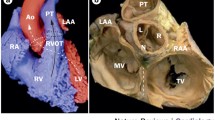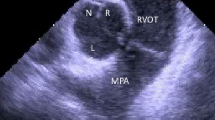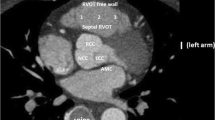Abstract
Idiopathic outflow tract ventricular tachycardia (VT) can arise from the right (RVOT) or left ventricular outflow tract (LVOT). The electrocardiographic (ECG) pattern of RVOT VT is typical in most patients, showing a monomorphic left bundle branch block (LBBB) QRS morphology with an inferior axis. Radiofrequency catheter ablation can be performed with a high success rate and provides a curative therapeutic approach. However, not all VTs with LBBB and inferior axis can be ablated from the RVOT. It has become apparent that LVOT VTs including VT originating from the aortic sinus of Valsalva or epicardium represent underrecognized VT entities which are also amenable to successful catheter ablation. Twelve-lead ECG criteria can contribute to distinguish between sites of VT origin.
LVOT arrhythmias represent an increasingly recognized VT entity which can be safely and successfully treated by catheter ablation. Identification of VT origin using ECG criteria and differentiation of LVOT versus RVOT origin is essential in the careful planning of the ablation strategy.
Zusammenfassung
Idiopathische ventrikuläre Ausflusstrakttachykardien (VTs) können sowohl im rechtsventrikulären (RVOT) als auch im linksventrikulären Ausflusstrakt (LVOT) entstehen. Das Elektrokardiogramm (EKG) einer RVOT-VT zeigt typischerweise einen monomorphen Linksschenkelblock mit einer inferioren Achse. Die Katheterablation ist als kurativer Ansatz mit einer sehr hohen Erfolgsrate gut etabliert. LVOT-VTs einschließlich VTs aus dem Bereich der Aortensinus oder mit epikardialem Ursprung stellen eher seltener diagnostizierte VT-Entitäten dar, die allerdings ebenfalls mittels Katheterablation erfolgreich behandelt werden können. Zur Unterscheidung zwischen VT-Ursprung im RVOT und LVOT können Zwölf-Kanal-EKG-Kriterien verwendet werden.
Arrhythmien aus dem LVOT können sicher und erfolgreich mit Katheterablation behandelt werden. Die Identifikation des VT-Ursprungs mittels EKG-Kriterien zur Differenzierung zwischen einem VT-Ursprung im LVOT und RVOT ist für die sorgfältige Planung der Katheterablationsstragie notwendig.
Similar content being viewed by others
Author information
Authors and Affiliations
Corresponding author
Rights and permissions
About this article
Cite this article
Chun, K.R.J., Satomi, K., Kuck, KH. et al. Left Ventricular Outflow Tract Tachycardia Including Ventricular Tachycardia from the Aortic Cusps and Epicardial Ventricular Tachycardia. Herz 32, 226–232 (2007). https://doi.org/10.1007/s00059-007-2977-0
Issue Date:
DOI: https://doi.org/10.1007/s00059-007-2977-0




